Psychology's Role in Understanding and Addressing Intergroup Conflict
VerifiedAdded on 2021/01/06
|9
|2680
|445
Essay
AI Summary
This essay explores the application of psychology, particularly social identity theory (SIT), in understanding and addressing intergroup conflict, including racial and intergroup conflict. It begins by outlining SIT's core tenets, emphasizing how group categorization, identification, and comparison contribute to in-group favoritism and out-group bias, leading to conflict. The essay then examines various psychological approaches to mitigate intergroup conflict, such as decategorization, recategorization, and the dual identity model, evaluating their effectiveness and limitations. It critiques SIT for overlooking cultural and biological factors and for not fully explaining how in-group favoritism translates to out-group hostility. The essay concludes by highlighting the need for future research that integrates psychological, historical, and ideological variables to comprehensively understand and address intergroup conflict. The study uses examples such as the behavior of the German people during the reign of the National Socialist regime under Adolf Hitler and the management of Uluru as a national park.
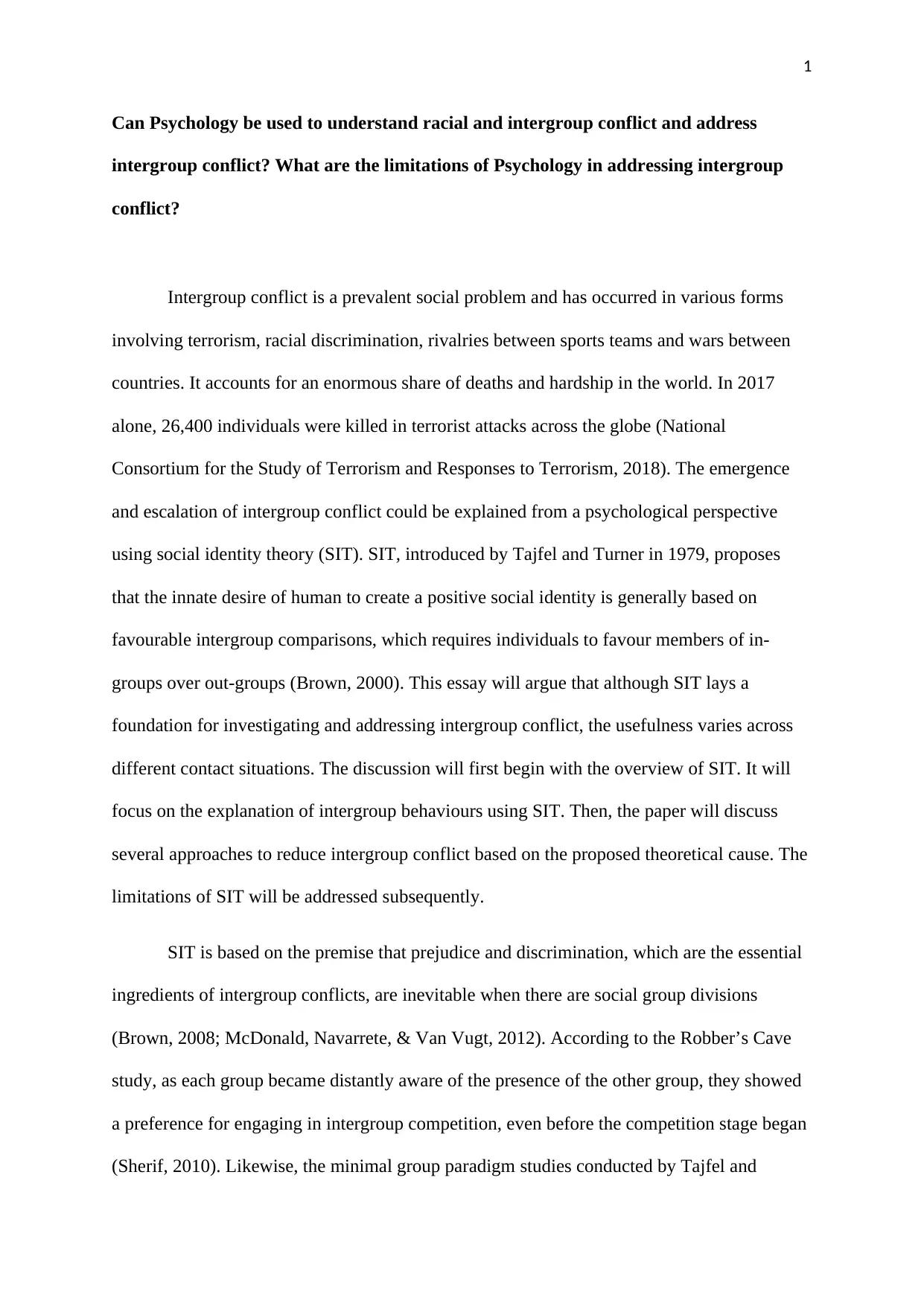
1
Can Psychology be used to understand racial and intergroup conflict and address
intergroup conflict? What are the limitations of Psychology in addressing intergroup
conflict?
Intergroup conflict is a prevalent social problem and has occurred in various forms
involving terrorism, racial discrimination, rivalries between sports teams and wars between
countries. It accounts for an enormous share of deaths and hardship in the world. In 2017
alone, 26,400 individuals were killed in terrorist attacks across the globe (National
Consortium for the Study of Terrorism and Responses to Terrorism, 2018). The emergence
and escalation of intergroup conflict could be explained from a psychological perspective
using social identity theory (SIT). SIT, introduced by Tajfel and Turner in 1979, proposes
that the innate desire of human to create a positive social identity is generally based on
favourable intergroup comparisons, which requires individuals to favour members of in-
groups over out-groups (Brown, 2000). This essay will argue that although SIT lays a
foundation for investigating and addressing intergroup conflict, the usefulness varies across
different contact situations. The discussion will first begin with the overview of SIT. It will
focus on the explanation of intergroup behaviours using SIT. Then, the paper will discuss
several approaches to reduce intergroup conflict based on the proposed theoretical cause. The
limitations of SIT will be addressed subsequently.
SIT is based on the premise that prejudice and discrimination, which are the essential
ingredients of intergroup conflicts, are inevitable when there are social group divisions
(Brown, 2008; McDonald, Navarrete, & Van Vugt, 2012). According to the Robber’s Cave
study, as each group became distantly aware of the presence of the other group, they showed
a preference for engaging in intergroup competition, even before the competition stage began
(Sherif, 2010). Likewise, the minimal group paradigm studies conducted by Tajfel and
Can Psychology be used to understand racial and intergroup conflict and address
intergroup conflict? What are the limitations of Psychology in addressing intergroup
conflict?
Intergroup conflict is a prevalent social problem and has occurred in various forms
involving terrorism, racial discrimination, rivalries between sports teams and wars between
countries. It accounts for an enormous share of deaths and hardship in the world. In 2017
alone, 26,400 individuals were killed in terrorist attacks across the globe (National
Consortium for the Study of Terrorism and Responses to Terrorism, 2018). The emergence
and escalation of intergroup conflict could be explained from a psychological perspective
using social identity theory (SIT). SIT, introduced by Tajfel and Turner in 1979, proposes
that the innate desire of human to create a positive social identity is generally based on
favourable intergroup comparisons, which requires individuals to favour members of in-
groups over out-groups (Brown, 2000). This essay will argue that although SIT lays a
foundation for investigating and addressing intergroup conflict, the usefulness varies across
different contact situations. The discussion will first begin with the overview of SIT. It will
focus on the explanation of intergroup behaviours using SIT. Then, the paper will discuss
several approaches to reduce intergroup conflict based on the proposed theoretical cause. The
limitations of SIT will be addressed subsequently.
SIT is based on the premise that prejudice and discrimination, which are the essential
ingredients of intergroup conflicts, are inevitable when there are social group divisions
(Brown, 2008; McDonald, Navarrete, & Van Vugt, 2012). According to the Robber’s Cave
study, as each group became distantly aware of the presence of the other group, they showed
a preference for engaging in intergroup competition, even before the competition stage began
(Sherif, 2010). Likewise, the minimal group paradigm studies conducted by Tajfel and
Paraphrase This Document
Need a fresh take? Get an instant paraphrase of this document with our AI Paraphraser
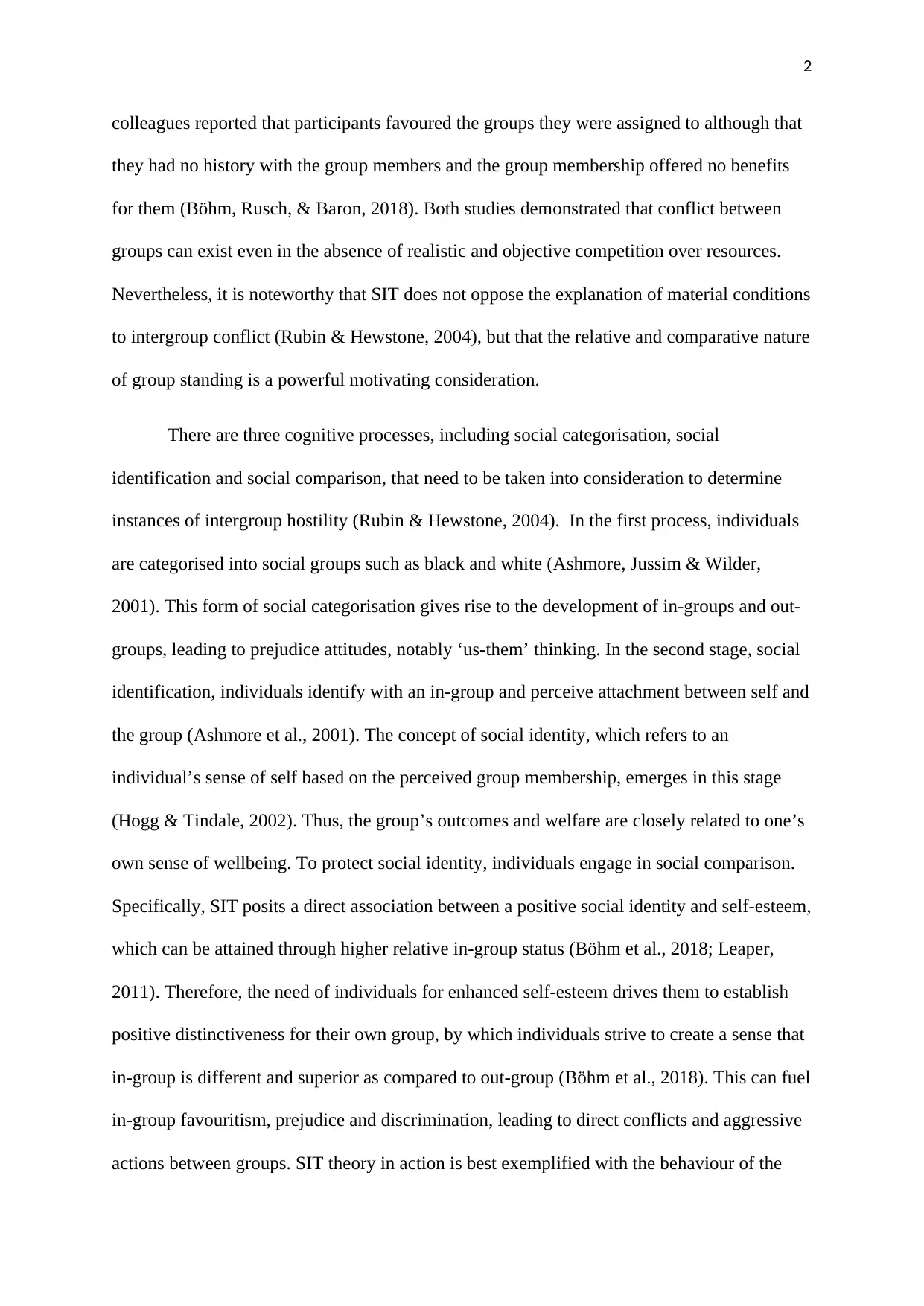
2
colleagues reported that participants favoured the groups they were assigned to although that
they had no history with the group members and the group membership offered no benefits
for them (Böhm, Rusch, & Baron, 2018). Both studies demonstrated that conflict between
groups can exist even in the absence of realistic and objective competition over resources.
Nevertheless, it is noteworthy that SIT does not oppose the explanation of material conditions
to intergroup conflict (Rubin & Hewstone, 2004), but that the relative and comparative nature
of group standing is a powerful motivating consideration.
There are three cognitive processes, including social categorisation, social
identification and social comparison, that need to be taken into consideration to determine
instances of intergroup hostility (Rubin & Hewstone, 2004). In the first process, individuals
are categorised into social groups such as black and white (Ashmore, Jussim & Wilder,
2001). This form of social categorisation gives rise to the development of in-groups and out-
groups, leading to prejudice attitudes, notably ‘us-them’ thinking. In the second stage, social
identification, individuals identify with an in-group and perceive attachment between self and
the group (Ashmore et al., 2001). The concept of social identity, which refers to an
individual’s sense of self based on the perceived group membership, emerges in this stage
(Hogg & Tindale, 2002). Thus, the group’s outcomes and welfare are closely related to one’s
own sense of wellbeing. To protect social identity, individuals engage in social comparison.
Specifically, SIT posits a direct association between a positive social identity and self-esteem,
which can be attained through higher relative in-group status (Böhm et al., 2018; Leaper,
2011). Therefore, the need of individuals for enhanced self-esteem drives them to establish
positive distinctiveness for their own group, by which individuals strive to create a sense that
in-group is different and superior as compared to out-group (Böhm et al., 2018). This can fuel
in-group favouritism, prejudice and discrimination, leading to direct conflicts and aggressive
actions between groups. SIT theory in action is best exemplified with the behaviour of the
colleagues reported that participants favoured the groups they were assigned to although that
they had no history with the group members and the group membership offered no benefits
for them (Böhm, Rusch, & Baron, 2018). Both studies demonstrated that conflict between
groups can exist even in the absence of realistic and objective competition over resources.
Nevertheless, it is noteworthy that SIT does not oppose the explanation of material conditions
to intergroup conflict (Rubin & Hewstone, 2004), but that the relative and comparative nature
of group standing is a powerful motivating consideration.
There are three cognitive processes, including social categorisation, social
identification and social comparison, that need to be taken into consideration to determine
instances of intergroup hostility (Rubin & Hewstone, 2004). In the first process, individuals
are categorised into social groups such as black and white (Ashmore, Jussim & Wilder,
2001). This form of social categorisation gives rise to the development of in-groups and out-
groups, leading to prejudice attitudes, notably ‘us-them’ thinking. In the second stage, social
identification, individuals identify with an in-group and perceive attachment between self and
the group (Ashmore et al., 2001). The concept of social identity, which refers to an
individual’s sense of self based on the perceived group membership, emerges in this stage
(Hogg & Tindale, 2002). Thus, the group’s outcomes and welfare are closely related to one’s
own sense of wellbeing. To protect social identity, individuals engage in social comparison.
Specifically, SIT posits a direct association between a positive social identity and self-esteem,
which can be attained through higher relative in-group status (Böhm et al., 2018; Leaper,
2011). Therefore, the need of individuals for enhanced self-esteem drives them to establish
positive distinctiveness for their own group, by which individuals strive to create a sense that
in-group is different and superior as compared to out-group (Böhm et al., 2018). This can fuel
in-group favouritism, prejudice and discrimination, leading to direct conflicts and aggressive
actions between groups. SIT theory in action is best exemplified with the behaviour of the
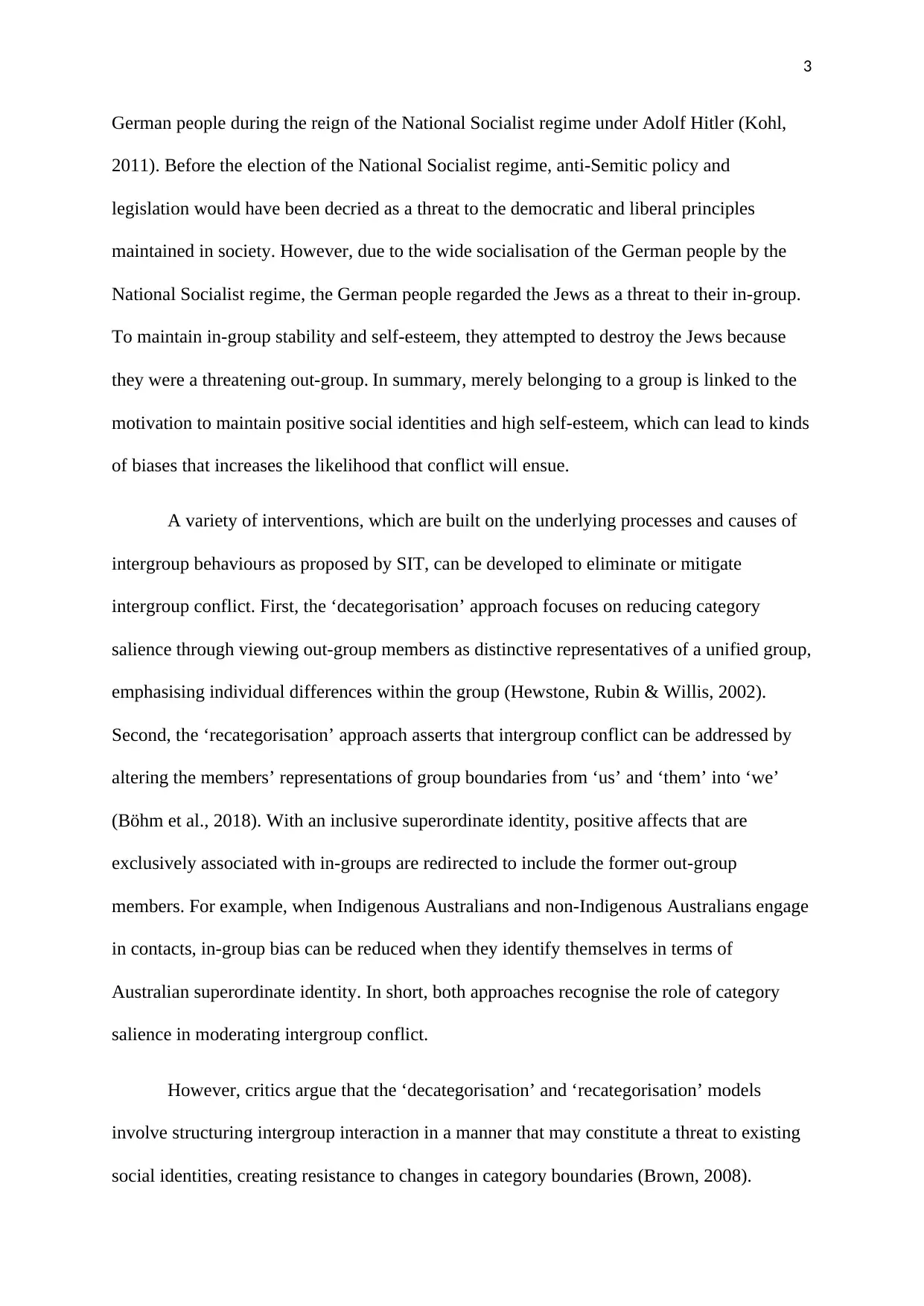
3
German people during the reign of the National Socialist regime under Adolf Hitler (Kohl,
2011). Before the election of the National Socialist regime, anti-Semitic policy and
legislation would have been decried as a threat to the democratic and liberal principles
maintained in society. However, due to the wide socialisation of the German people by the
National Socialist regime, the German people regarded the Jews as a threat to their in-group.
To maintain in-group stability and self-esteem, they attempted to destroy the Jews because
they were a threatening out-group. In summary, merely belonging to a group is linked to the
motivation to maintain positive social identities and high self-esteem, which can lead to kinds
of biases that increases the likelihood that conflict will ensue.
A variety of interventions, which are built on the underlying processes and causes of
intergroup behaviours as proposed by SIT, can be developed to eliminate or mitigate
intergroup conflict. First, the ‘decategorisation’ approach focuses on reducing category
salience through viewing out-group members as distinctive representatives of a unified group,
emphasising individual differences within the group (Hewstone, Rubin & Willis, 2002).
Second, the ‘recategorisation’ approach asserts that intergroup conflict can be addressed by
altering the members’ representations of group boundaries from ‘us’ and ‘them’ into ‘we’
(Böhm et al., 2018). With an inclusive superordinate identity, positive affects that are
exclusively associated with in-groups are redirected to include the former out-group
members. For example, when Indigenous Australians and non-Indigenous Australians engage
in contacts, in-group bias can be reduced when they identify themselves in terms of
Australian superordinate identity. In short, both approaches recognise the role of category
salience in moderating intergroup conflict.
However, critics argue that the ‘decategorisation’ and ‘recategorisation’ models
involve structuring intergroup interaction in a manner that may constitute a threat to existing
social identities, creating resistance to changes in category boundaries (Brown, 2008).
German people during the reign of the National Socialist regime under Adolf Hitler (Kohl,
2011). Before the election of the National Socialist regime, anti-Semitic policy and
legislation would have been decried as a threat to the democratic and liberal principles
maintained in society. However, due to the wide socialisation of the German people by the
National Socialist regime, the German people regarded the Jews as a threat to their in-group.
To maintain in-group stability and self-esteem, they attempted to destroy the Jews because
they were a threatening out-group. In summary, merely belonging to a group is linked to the
motivation to maintain positive social identities and high self-esteem, which can lead to kinds
of biases that increases the likelihood that conflict will ensue.
A variety of interventions, which are built on the underlying processes and causes of
intergroup behaviours as proposed by SIT, can be developed to eliminate or mitigate
intergroup conflict. First, the ‘decategorisation’ approach focuses on reducing category
salience through viewing out-group members as distinctive representatives of a unified group,
emphasising individual differences within the group (Hewstone, Rubin & Willis, 2002).
Second, the ‘recategorisation’ approach asserts that intergroup conflict can be addressed by
altering the members’ representations of group boundaries from ‘us’ and ‘them’ into ‘we’
(Böhm et al., 2018). With an inclusive superordinate identity, positive affects that are
exclusively associated with in-groups are redirected to include the former out-group
members. For example, when Indigenous Australians and non-Indigenous Australians engage
in contacts, in-group bias can be reduced when they identify themselves in terms of
Australian superordinate identity. In short, both approaches recognise the role of category
salience in moderating intergroup conflict.
However, critics argue that the ‘decategorisation’ and ‘recategorisation’ models
involve structuring intergroup interaction in a manner that may constitute a threat to existing
social identities, creating resistance to changes in category boundaries (Brown, 2008).
⊘ This is a preview!⊘
Do you want full access?
Subscribe today to unlock all pages.

Trusted by 1+ million students worldwide
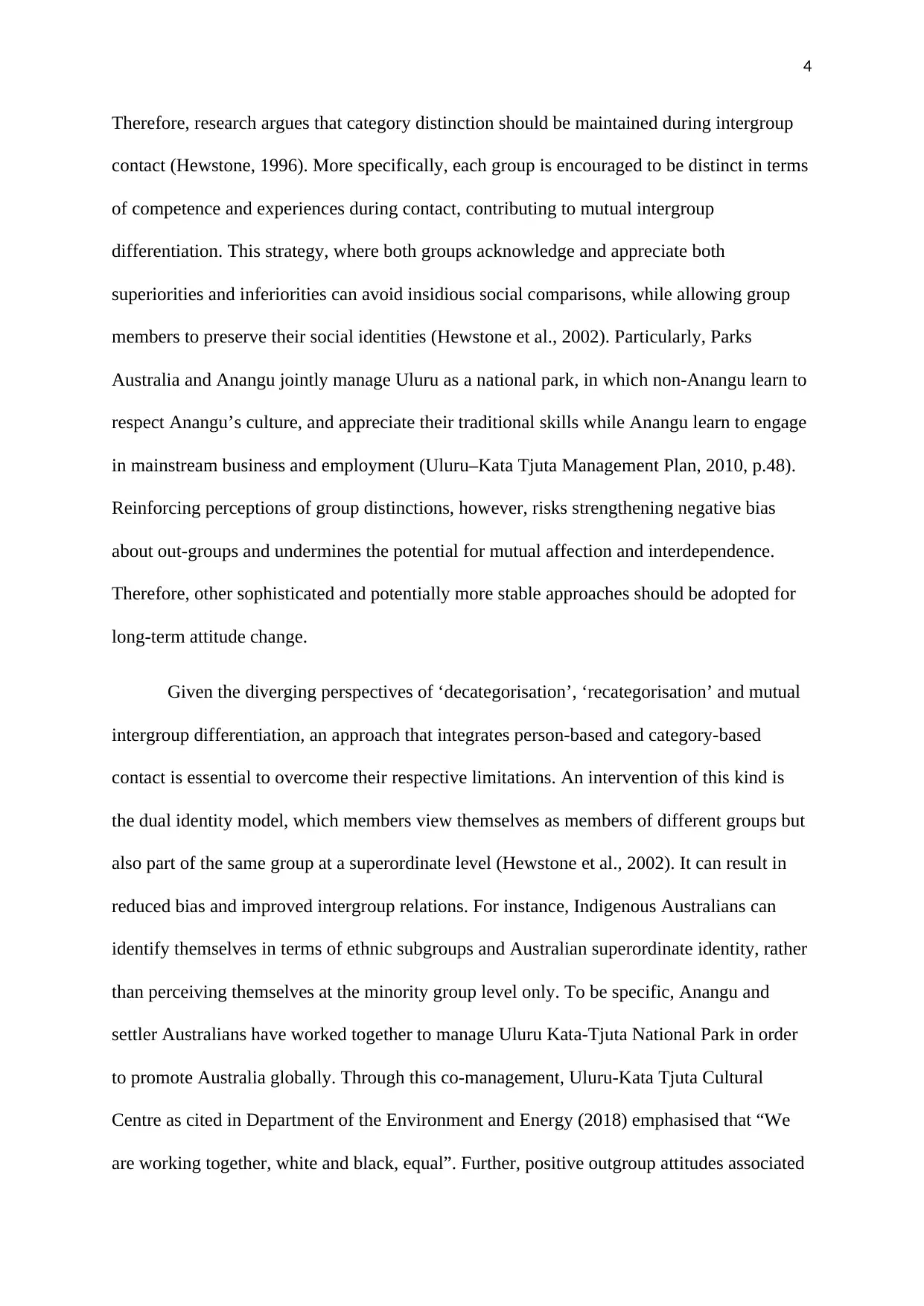
4
Therefore, research argues that category distinction should be maintained during intergroup
contact (Hewstone, 1996). More specifically, each group is encouraged to be distinct in terms
of competence and experiences during contact, contributing to mutual intergroup
differentiation. This strategy, where both groups acknowledge and appreciate both
superiorities and inferiorities can avoid insidious social comparisons, while allowing group
members to preserve their social identities (Hewstone et al., 2002). Particularly, Parks
Australia and Anangu jointly manage Uluru as a national park, in which non-Anangu learn to
respect Anangu’s culture, and appreciate their traditional skills while Anangu learn to engage
in mainstream business and employment (Uluru–Kata Tjuta Management Plan, 2010, p.48).
Reinforcing perceptions of group distinctions, however, risks strengthening negative bias
about out-groups and undermines the potential for mutual affection and interdependence.
Therefore, other sophisticated and potentially more stable approaches should be adopted for
long-term attitude change.
Given the diverging perspectives of ‘decategorisation’, ‘recategorisation’ and mutual
intergroup differentiation, an approach that integrates person-based and category-based
contact is essential to overcome their respective limitations. An intervention of this kind is
the dual identity model, which members view themselves as members of different groups but
also part of the same group at a superordinate level (Hewstone et al., 2002). It can result in
reduced bias and improved intergroup relations. For instance, Indigenous Australians can
identify themselves in terms of ethnic subgroups and Australian superordinate identity, rather
than perceiving themselves at the minority group level only. To be specific, Anangu and
settler Australians have worked together to manage Uluru Kata-Tjuta National Park in order
to promote Australia globally. Through this co-management, Uluru-Kata Tjuta Cultural
Centre as cited in Department of the Environment and Energy (2018) emphasised that “We
are working together, white and black, equal”. Further, positive outgroup attitudes associated
Therefore, research argues that category distinction should be maintained during intergroup
contact (Hewstone, 1996). More specifically, each group is encouraged to be distinct in terms
of competence and experiences during contact, contributing to mutual intergroup
differentiation. This strategy, where both groups acknowledge and appreciate both
superiorities and inferiorities can avoid insidious social comparisons, while allowing group
members to preserve their social identities (Hewstone et al., 2002). Particularly, Parks
Australia and Anangu jointly manage Uluru as a national park, in which non-Anangu learn to
respect Anangu’s culture, and appreciate their traditional skills while Anangu learn to engage
in mainstream business and employment (Uluru–Kata Tjuta Management Plan, 2010, p.48).
Reinforcing perceptions of group distinctions, however, risks strengthening negative bias
about out-groups and undermines the potential for mutual affection and interdependence.
Therefore, other sophisticated and potentially more stable approaches should be adopted for
long-term attitude change.
Given the diverging perspectives of ‘decategorisation’, ‘recategorisation’ and mutual
intergroup differentiation, an approach that integrates person-based and category-based
contact is essential to overcome their respective limitations. An intervention of this kind is
the dual identity model, which members view themselves as members of different groups but
also part of the same group at a superordinate level (Hewstone et al., 2002). It can result in
reduced bias and improved intergroup relations. For instance, Indigenous Australians can
identify themselves in terms of ethnic subgroups and Australian superordinate identity, rather
than perceiving themselves at the minority group level only. To be specific, Anangu and
settler Australians have worked together to manage Uluru Kata-Tjuta National Park in order
to promote Australia globally. Through this co-management, Uluru-Kata Tjuta Cultural
Centre as cited in Department of the Environment and Energy (2018) emphasised that “We
are working together, white and black, equal”. Further, positive outgroup attitudes associated
Paraphrase This Document
Need a fresh take? Get an instant paraphrase of this document with our AI Paraphraser
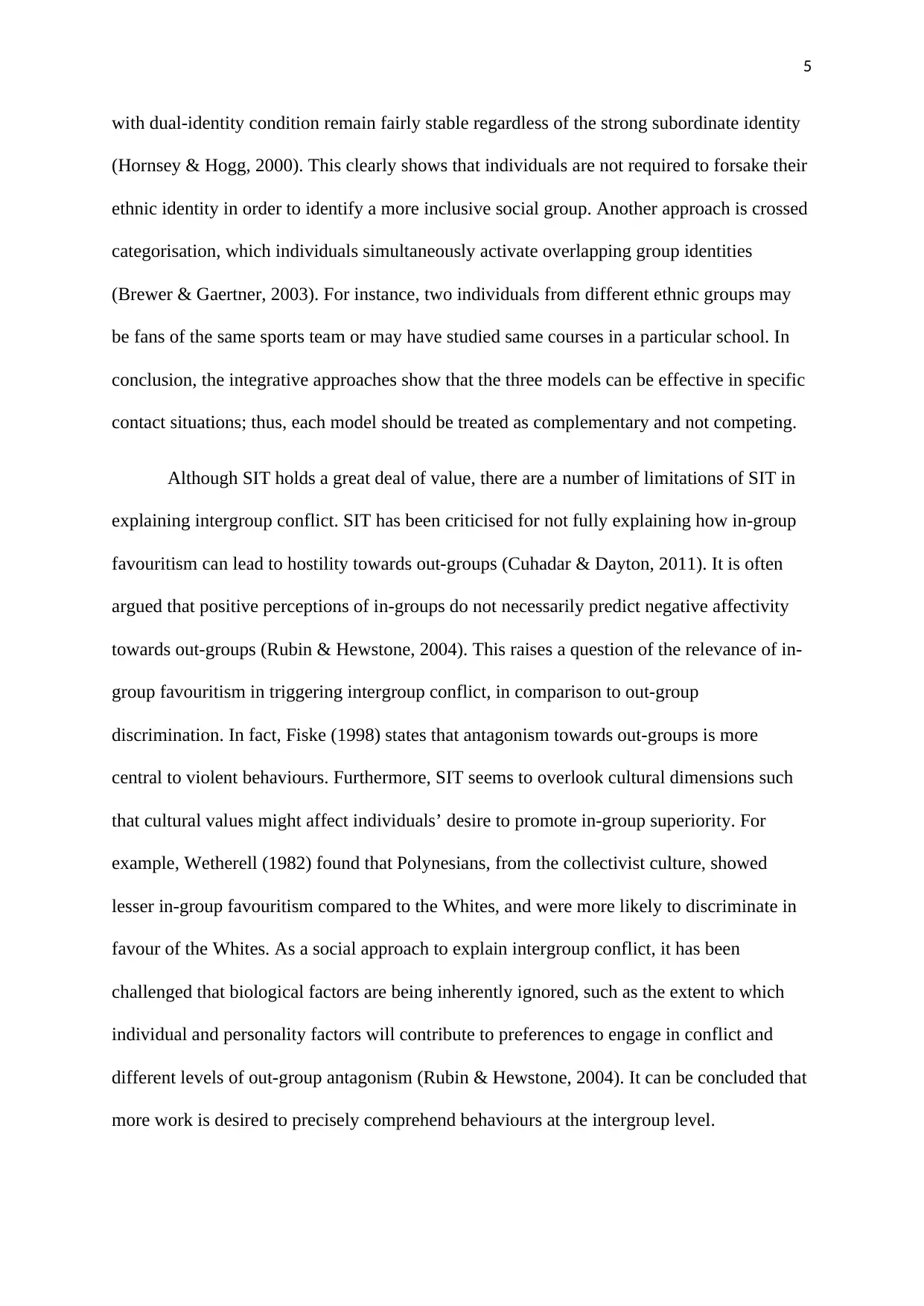
5
with dual-identity condition remain fairly stable regardless of the strong subordinate identity
(Hornsey & Hogg, 2000). This clearly shows that individuals are not required to forsake their
ethnic identity in order to identify a more inclusive social group. Another approach is crossed
categorisation, which individuals simultaneously activate overlapping group identities
(Brewer & Gaertner, 2003). For instance, two individuals from different ethnic groups may
be fans of the same sports team or may have studied same courses in a particular school. In
conclusion, the integrative approaches show that the three models can be effective in specific
contact situations; thus, each model should be treated as complementary and not competing.
Although SIT holds a great deal of value, there are a number of limitations of SIT in
explaining intergroup conflict. SIT has been criticised for not fully explaining how in-group
favouritism can lead to hostility towards out-groups (Cuhadar & Dayton, 2011). It is often
argued that positive perceptions of in-groups do not necessarily predict negative affectivity
towards out-groups (Rubin & Hewstone, 2004). This raises a question of the relevance of in-
group favouritism in triggering intergroup conflict, in comparison to out-group
discrimination. In fact, Fiske (1998) states that antagonism towards out-groups is more
central to violent behaviours. Furthermore, SIT seems to overlook cultural dimensions such
that cultural values might affect individuals’ desire to promote in-group superiority. For
example, Wetherell (1982) found that Polynesians, from the collectivist culture, showed
lesser in-group favouritism compared to the Whites, and were more likely to discriminate in
favour of the Whites. As a social approach to explain intergroup conflict, it has been
challenged that biological factors are being inherently ignored, such as the extent to which
individual and personality factors will contribute to preferences to engage in conflict and
different levels of out-group antagonism (Rubin & Hewstone, 2004). It can be concluded that
more work is desired to precisely comprehend behaviours at the intergroup level.
with dual-identity condition remain fairly stable regardless of the strong subordinate identity
(Hornsey & Hogg, 2000). This clearly shows that individuals are not required to forsake their
ethnic identity in order to identify a more inclusive social group. Another approach is crossed
categorisation, which individuals simultaneously activate overlapping group identities
(Brewer & Gaertner, 2003). For instance, two individuals from different ethnic groups may
be fans of the same sports team or may have studied same courses in a particular school. In
conclusion, the integrative approaches show that the three models can be effective in specific
contact situations; thus, each model should be treated as complementary and not competing.
Although SIT holds a great deal of value, there are a number of limitations of SIT in
explaining intergroup conflict. SIT has been criticised for not fully explaining how in-group
favouritism can lead to hostility towards out-groups (Cuhadar & Dayton, 2011). It is often
argued that positive perceptions of in-groups do not necessarily predict negative affectivity
towards out-groups (Rubin & Hewstone, 2004). This raises a question of the relevance of in-
group favouritism in triggering intergroup conflict, in comparison to out-group
discrimination. In fact, Fiske (1998) states that antagonism towards out-groups is more
central to violent behaviours. Furthermore, SIT seems to overlook cultural dimensions such
that cultural values might affect individuals’ desire to promote in-group superiority. For
example, Wetherell (1982) found that Polynesians, from the collectivist culture, showed
lesser in-group favouritism compared to the Whites, and were more likely to discriminate in
favour of the Whites. As a social approach to explain intergroup conflict, it has been
challenged that biological factors are being inherently ignored, such as the extent to which
individual and personality factors will contribute to preferences to engage in conflict and
different levels of out-group antagonism (Rubin & Hewstone, 2004). It can be concluded that
more work is desired to precisely comprehend behaviours at the intergroup level.
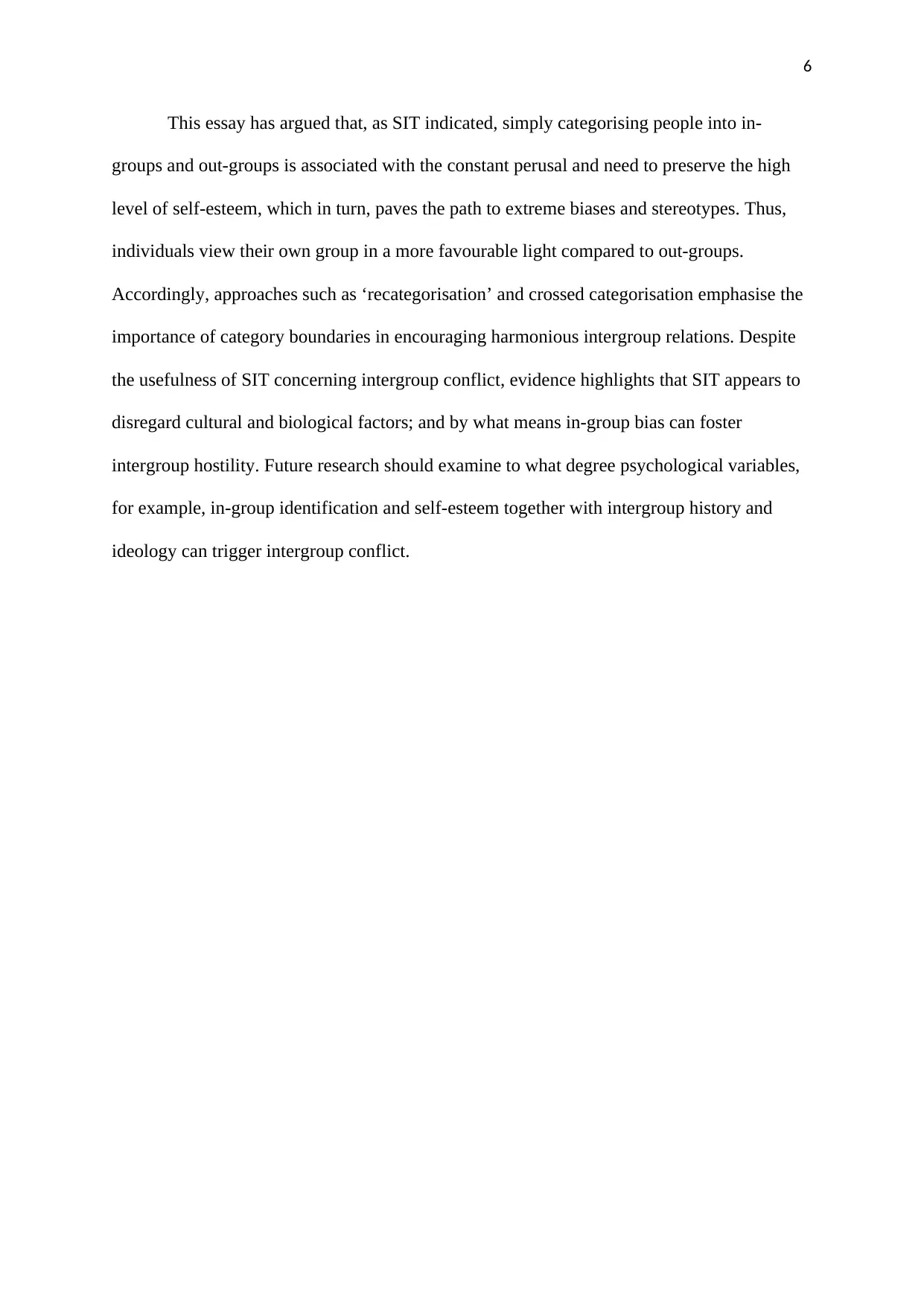
6
This essay has argued that, as SIT indicated, simply categorising people into in-
groups and out-groups is associated with the constant perusal and need to preserve the high
level of self-esteem, which in turn, paves the path to extreme biases and stereotypes. Thus,
individuals view their own group in a more favourable light compared to out-groups.
Accordingly, approaches such as ‘recategorisation’ and crossed categorisation emphasise the
importance of category boundaries in encouraging harmonious intergroup relations. Despite
the usefulness of SIT concerning intergroup conflict, evidence highlights that SIT appears to
disregard cultural and biological factors; and by what means in-group bias can foster
intergroup hostility. Future research should examine to what degree psychological variables,
for example, in-group identification and self-esteem together with intergroup history and
ideology can trigger intergroup conflict.
This essay has argued that, as SIT indicated, simply categorising people into in-
groups and out-groups is associated with the constant perusal and need to preserve the high
level of self-esteem, which in turn, paves the path to extreme biases and stereotypes. Thus,
individuals view their own group in a more favourable light compared to out-groups.
Accordingly, approaches such as ‘recategorisation’ and crossed categorisation emphasise the
importance of category boundaries in encouraging harmonious intergroup relations. Despite
the usefulness of SIT concerning intergroup conflict, evidence highlights that SIT appears to
disregard cultural and biological factors; and by what means in-group bias can foster
intergroup hostility. Future research should examine to what degree psychological variables,
for example, in-group identification and self-esteem together with intergroup history and
ideology can trigger intergroup conflict.
⊘ This is a preview!⊘
Do you want full access?
Subscribe today to unlock all pages.

Trusted by 1+ million students worldwide
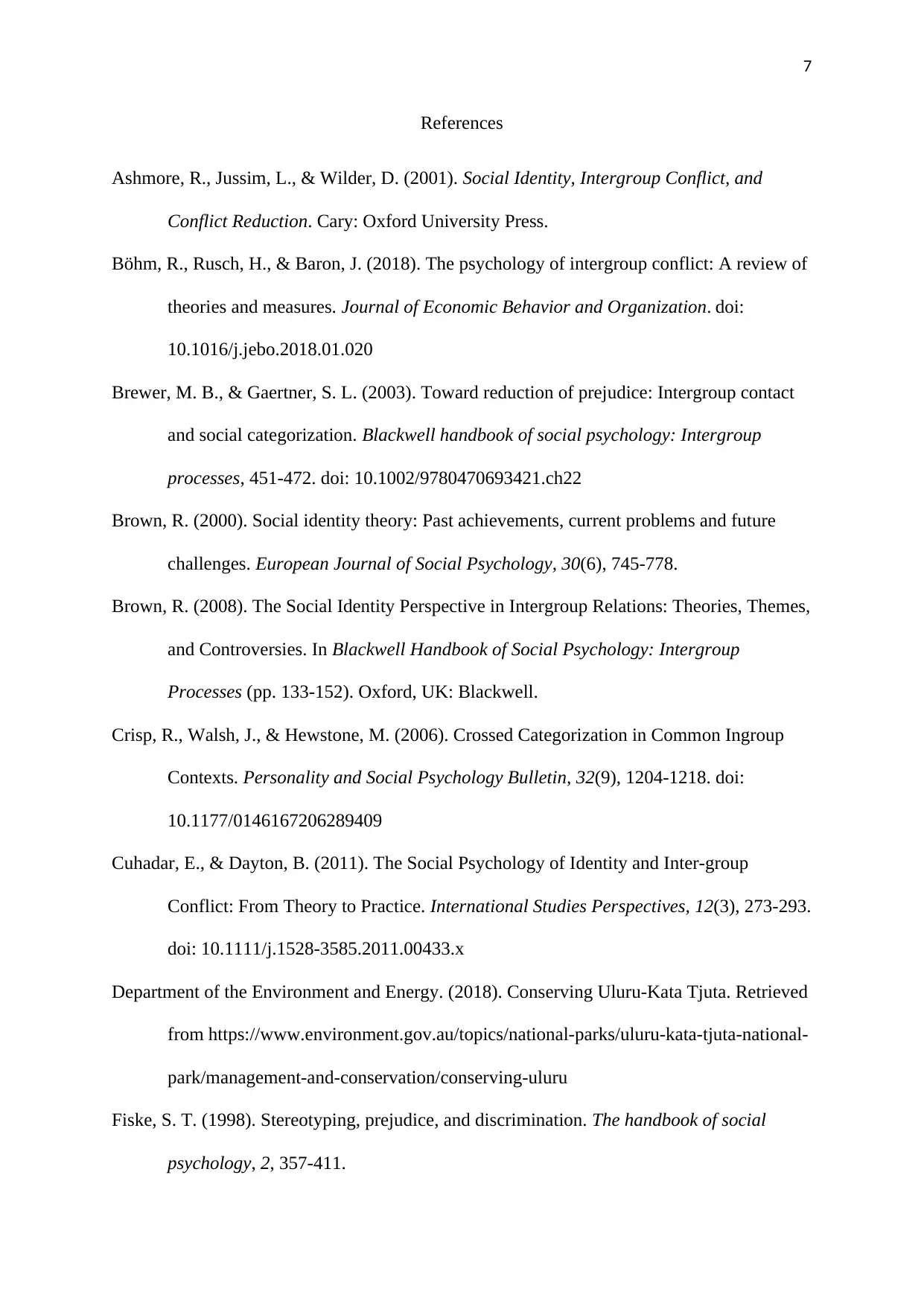
7
References
Ashmore, R., Jussim, L., & Wilder, D. (2001). Social Identity, Intergroup Conflict, and
Conflict Reduction. Cary: Oxford University Press.
Böhm, R., Rusch, H., & Baron, J. (2018). The psychology of intergroup conflict: A review of
theories and measures. Journal of Economic Behavior and Organization. doi:
10.1016/j.jebo.2018.01.020
Brewer, M. B., & Gaertner, S. L. (2003). Toward reduction of prejudice: Intergroup contact
and social categorization. Blackwell handbook of social psychology: Intergroup
processes, 451-472. doi: 10.1002/9780470693421.ch22
Brown, R. (2000). Social identity theory: Past achievements, current problems and future
challenges. European Journal of Social Psychology, 30(6), 745-778.
Brown, R. (2008). The Social Identity Perspective in Intergroup Relations: Theories, Themes,
and Controversies. In Blackwell Handbook of Social Psychology: Intergroup
Processes (pp. 133-152). Oxford, UK: Blackwell.
Crisp, R., Walsh, J., & Hewstone, M. (2006). Crossed Categorization in Common Ingroup
Contexts. Personality and Social Psychology Bulletin, 32(9), 1204-1218. doi:
10.1177/0146167206289409
Cuhadar, E., & Dayton, B. (2011). The Social Psychology of Identity and Inter‐group
Conflict: From Theory to Practice. International Studies Perspectives, 12(3), 273-293.
doi: 10.1111/j.1528-3585.2011.00433.x
Department of the Environment and Energy. (2018). Conserving Uluru-Kata Tjuta. Retrieved
from https://www.environment.gov.au/topics/national-parks/uluru-kata-tjuta-national-
park/management-and-conservation/conserving-uluru
Fiske, S. T. (1998). Stereotyping, prejudice, and discrimination. The handbook of social
psychology, 2, 357-411.
References
Ashmore, R., Jussim, L., & Wilder, D. (2001). Social Identity, Intergroup Conflict, and
Conflict Reduction. Cary: Oxford University Press.
Böhm, R., Rusch, H., & Baron, J. (2018). The psychology of intergroup conflict: A review of
theories and measures. Journal of Economic Behavior and Organization. doi:
10.1016/j.jebo.2018.01.020
Brewer, M. B., & Gaertner, S. L. (2003). Toward reduction of prejudice: Intergroup contact
and social categorization. Blackwell handbook of social psychology: Intergroup
processes, 451-472. doi: 10.1002/9780470693421.ch22
Brown, R. (2000). Social identity theory: Past achievements, current problems and future
challenges. European Journal of Social Psychology, 30(6), 745-778.
Brown, R. (2008). The Social Identity Perspective in Intergroup Relations: Theories, Themes,
and Controversies. In Blackwell Handbook of Social Psychology: Intergroup
Processes (pp. 133-152). Oxford, UK: Blackwell.
Crisp, R., Walsh, J., & Hewstone, M. (2006). Crossed Categorization in Common Ingroup
Contexts. Personality and Social Psychology Bulletin, 32(9), 1204-1218. doi:
10.1177/0146167206289409
Cuhadar, E., & Dayton, B. (2011). The Social Psychology of Identity and Inter‐group
Conflict: From Theory to Practice. International Studies Perspectives, 12(3), 273-293.
doi: 10.1111/j.1528-3585.2011.00433.x
Department of the Environment and Energy. (2018). Conserving Uluru-Kata Tjuta. Retrieved
from https://www.environment.gov.au/topics/national-parks/uluru-kata-tjuta-national-
park/management-and-conservation/conserving-uluru
Fiske, S. T. (1998). Stereotyping, prejudice, and discrimination. The handbook of social
psychology, 2, 357-411.
Paraphrase This Document
Need a fresh take? Get an instant paraphrase of this document with our AI Paraphraser
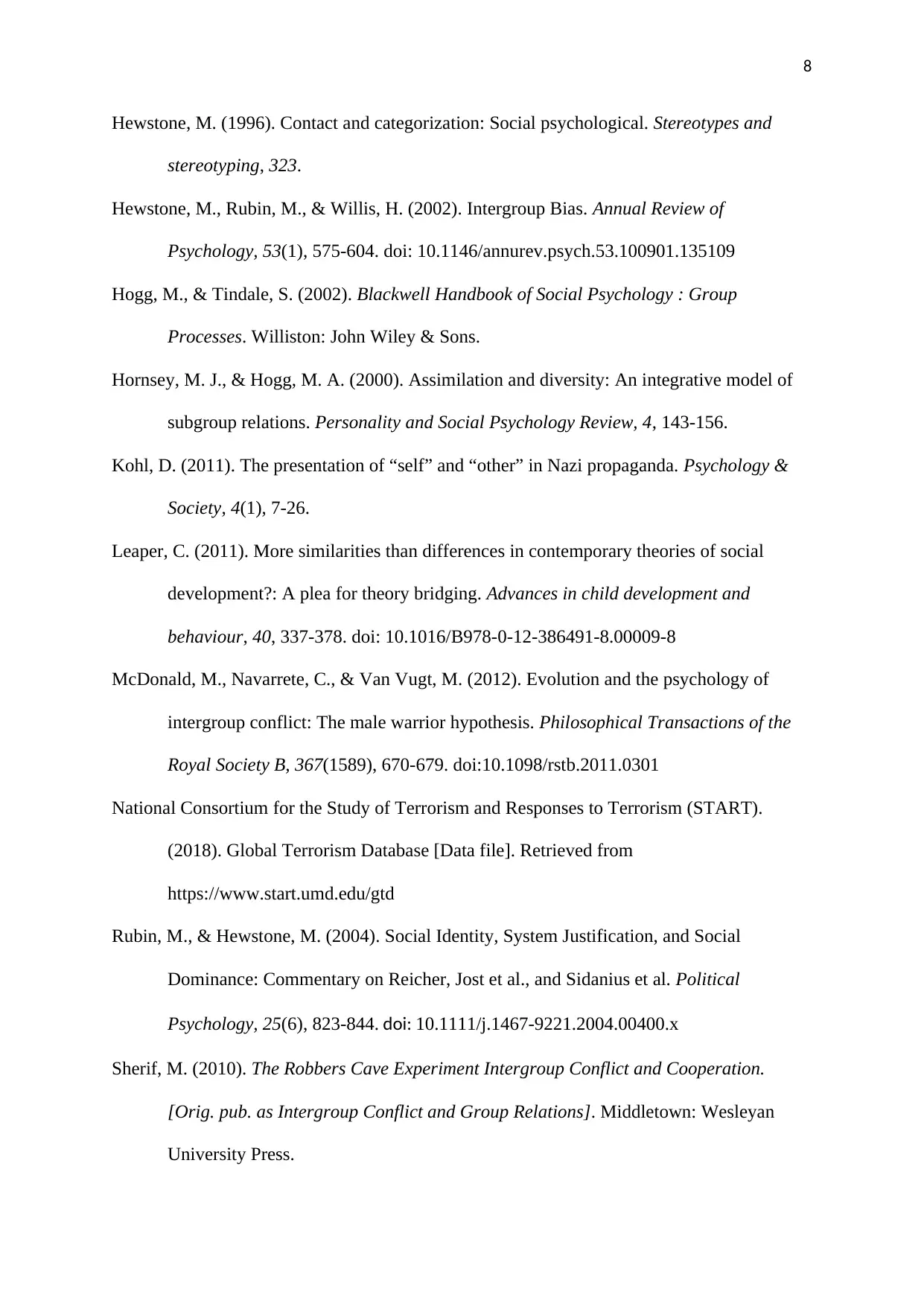
8
Hewstone, M. (1996). Contact and categorization: Social psychological. Stereotypes and
stereotyping, 323.
Hewstone, M., Rubin, M., & Willis, H. (2002). Intergroup Bias. Annual Review of
Psychology, 53(1), 575-604. doi: 10.1146/annurev.psych.53.100901.135109
Hogg, M., & Tindale, S. (2002). Blackwell Handbook of Social Psychology : Group
Processes. Williston: John Wiley & Sons.
Hornsey, M. J., & Hogg, M. A. (2000). Assimilation and diversity: An integrative model of
subgroup relations. Personality and Social Psychology Review, 4, 143-156.
Kohl, D. (2011). The presentation of “self” and “other” in Nazi propaganda. Psychology &
Society, 4(1), 7-26.
Leaper, C. (2011). More similarities than differences in contemporary theories of social
development?: A plea for theory bridging. Advances in child development and
behaviour, 40, 337-378. doi: 10.1016/B978-0-12-386491-8.00009-8
McDonald, M., Navarrete, C., & Van Vugt, M. (2012). Evolution and the psychology of
intergroup conflict: The male warrior hypothesis. Philosophical Transactions of the
Royal Society B, 367(1589), 670-679. doi:10.1098/rstb.2011.0301
National Consortium for the Study of Terrorism and Responses to Terrorism (START).
(2018). Global Terrorism Database [Data file]. Retrieved from
https://www.start.umd.edu/gtd
Rubin, M., & Hewstone, M. (2004). Social Identity, System Justification, and Social
Dominance: Commentary on Reicher, Jost et al., and Sidanius et al. Political
Psychology, 25(6), 823-844. doi: 10.1111/j.1467-9221.2004.00400.x
Sherif, M. (2010). The Robbers Cave Experiment Intergroup Conflict and Cooperation.
[Orig. pub. as Intergroup Conflict and Group Relations]. Middletown: Wesleyan
University Press.
Hewstone, M. (1996). Contact and categorization: Social psychological. Stereotypes and
stereotyping, 323.
Hewstone, M., Rubin, M., & Willis, H. (2002). Intergroup Bias. Annual Review of
Psychology, 53(1), 575-604. doi: 10.1146/annurev.psych.53.100901.135109
Hogg, M., & Tindale, S. (2002). Blackwell Handbook of Social Psychology : Group
Processes. Williston: John Wiley & Sons.
Hornsey, M. J., & Hogg, M. A. (2000). Assimilation and diversity: An integrative model of
subgroup relations. Personality and Social Psychology Review, 4, 143-156.
Kohl, D. (2011). The presentation of “self” and “other” in Nazi propaganda. Psychology &
Society, 4(1), 7-26.
Leaper, C. (2011). More similarities than differences in contemporary theories of social
development?: A plea for theory bridging. Advances in child development and
behaviour, 40, 337-378. doi: 10.1016/B978-0-12-386491-8.00009-8
McDonald, M., Navarrete, C., & Van Vugt, M. (2012). Evolution and the psychology of
intergroup conflict: The male warrior hypothesis. Philosophical Transactions of the
Royal Society B, 367(1589), 670-679. doi:10.1098/rstb.2011.0301
National Consortium for the Study of Terrorism and Responses to Terrorism (START).
(2018). Global Terrorism Database [Data file]. Retrieved from
https://www.start.umd.edu/gtd
Rubin, M., & Hewstone, M. (2004). Social Identity, System Justification, and Social
Dominance: Commentary on Reicher, Jost et al., and Sidanius et al. Political
Psychology, 25(6), 823-844. doi: 10.1111/j.1467-9221.2004.00400.x
Sherif, M. (2010). The Robbers Cave Experiment Intergroup Conflict and Cooperation.
[Orig. pub. as Intergroup Conflict and Group Relations]. Middletown: Wesleyan
University Press.
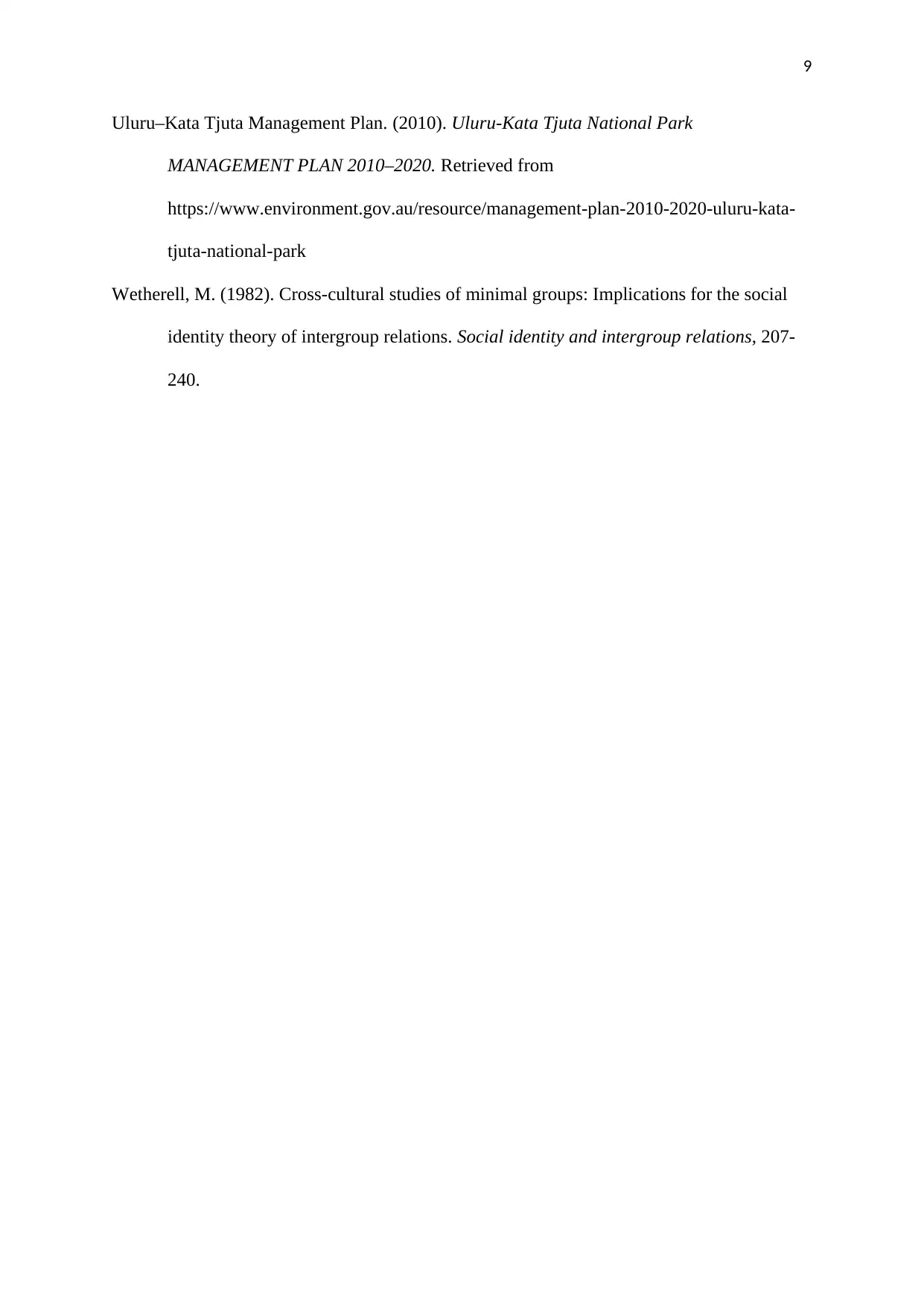
9
Uluru–Kata Tjuta Management Plan. (2010). Uluru-Kata Tjuta National Park
MANAGEMENT PLAN 2010–2020. Retrieved from
https://www.environment.gov.au/resource/management-plan-2010-2020-uluru-kata-
tjuta-national-park
Wetherell, M. (1982). Cross-cultural studies of minimal groups: Implications for the social
identity theory of intergroup relations. Social identity and intergroup relations, 207-
240.
Uluru–Kata Tjuta Management Plan. (2010). Uluru-Kata Tjuta National Park
MANAGEMENT PLAN 2010–2020. Retrieved from
https://www.environment.gov.au/resource/management-plan-2010-2020-uluru-kata-
tjuta-national-park
Wetherell, M. (1982). Cross-cultural studies of minimal groups: Implications for the social
identity theory of intergroup relations. Social identity and intergroup relations, 207-
240.
⊘ This is a preview!⊘
Do you want full access?
Subscribe today to unlock all pages.

Trusted by 1+ million students worldwide
1 out of 9
Your All-in-One AI-Powered Toolkit for Academic Success.
+13062052269
info@desklib.com
Available 24*7 on WhatsApp / Email
![[object Object]](/_next/static/media/star-bottom.7253800d.svg)
Unlock your academic potential
Copyright © 2020–2025 A2Z Services. All Rights Reserved. Developed and managed by ZUCOL.

